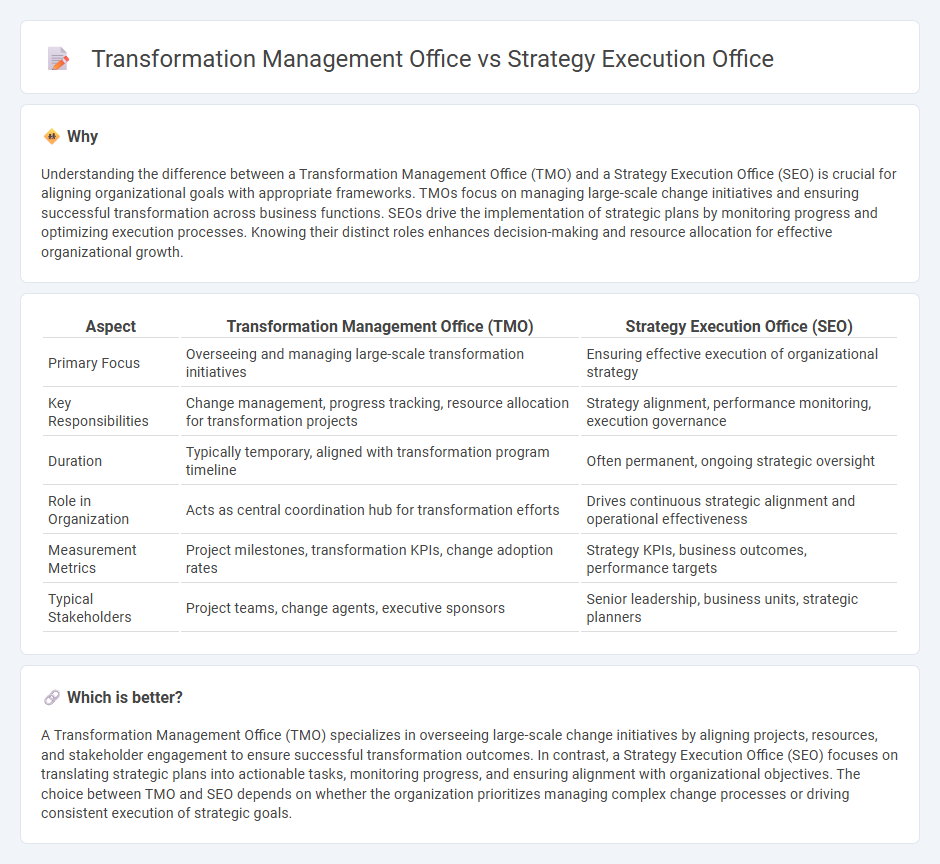
Transformation Management Office focuses on driving organizational change initiatives by overseeing project implementation, aligning resources, and managing stakeholder communication to achieve strategic business transformation. Strategy Execution Office ensures the effective translation of strategic plans into operational results by monitoring key performance indicators, managing cross-functional collaboration, and optimizing resource allocation. Discover how each office can elevate your company's growth by exploring their distinct roles and impact.
Why it is important
Understanding the difference between a Transformation Management Office (TMO) and a Strategy Execution Office (SEO) is crucial for aligning organizational goals with appropriate frameworks. TMOs focus on managing large-scale change initiatives and ensuring successful transformation across business functions. SEOs drive the implementation of strategic plans by monitoring progress and optimizing execution processes. Knowing their distinct roles enhances decision-making and resource allocation for effective organizational growth.
Comparison Table
| Aspect | Transformation Management Office (TMO) | Strategy Execution Office (SEO) |
|---|---|---|
| Primary Focus | Overseeing and managing large-scale transformation initiatives | Ensuring effective execution of organizational strategy |
| Key Responsibilities | Change management, progress tracking, resource allocation for transformation projects | Strategy alignment, performance monitoring, execution governance |
| Duration | Typically temporary, aligned with transformation program timeline | Often permanent, ongoing strategic oversight |
| Role in Organization | Acts as central coordination hub for transformation efforts | Drives continuous strategic alignment and operational effectiveness |
| Measurement Metrics | Project milestones, transformation KPIs, change adoption rates | Strategy KPIs, business outcomes, performance targets |
| Typical Stakeholders | Project teams, change agents, executive sponsors | Senior leadership, business units, strategic planners |
Which is better?
A Transformation Management Office (TMO) specializes in overseeing large-scale change initiatives by aligning projects, resources, and stakeholder engagement to ensure successful transformation outcomes. In contrast, a Strategy Execution Office (SEO) focuses on translating strategic plans into actionable tasks, monitoring progress, and ensuring alignment with organizational objectives. The choice between TMO and SEO depends on whether the organization prioritizes managing complex change processes or driving consistent execution of strategic goals.
Connection
The Transformation Management Office (TMO) and Strategy Execution Office (SEO) align closely by ensuring organizational change initiatives directly support strategic goals. The TMO focuses on managing and driving transformation projects, while the SEO oversees the implementation of strategic plans to achieve business objectives. This connection enables streamlined governance, continuous performance tracking, and effective resource allocation across both transformation and strategy execution efforts.
Key Terms
Operating Model
The Strategy Execution Office (SEO) primarily focuses on aligning projects and initiatives with the organization's business objectives to optimize the operating model's efficiency and effectiveness. In contrast, the Transformation Management Office (TMO) drives large-scale change initiatives, emphasizing the redesign and evolution of the operating model to support new strategic directions or market demands. Explore key differences and best practices to enhance operating model success in dynamic business environments.
Change Management
The Strategy Execution Office (SEO) primarily aligns organizational initiatives with business goals, emphasizing performance tracking and accountability, while the Transformation Management Office (TMO) focuses extensively on change management, steering cultural shifts and adoption of new processes. TMOs employ change management frameworks, stakeholder engagement strategies, and communication plans to minimize resistance and ensure smooth transitions during transformational efforts. Explore detailed methodologies and best practices to enhance your organization's change management effectiveness.
Performance Metrics
The Strategy Execution Office (SEO) emphasizes tracking performance metrics aligned with strategic goals, using key performance indicators (KPIs) like revenue growth, market share, and operational efficiency to ensure initiatives meet organizational objectives. In contrast, the Transformation Management Office (TMO) prioritizes metrics related to change adoption, project milestones, and stakeholder engagement to drive successful transformation outcomes and minimize resistance. Explore in-depth comparisons and best practices for effective performance measurement in both offices.
Source and External Links
A framework for strategy execution integrating the PMO and OCM - The Strategy Execution Office, often called the Office of Strategy Management (OSM), is responsible for developing, managing, and reviewing strategy through core processes like scorecard management, organization alignment, and strategy reviews, as well as integrating budgeting, workforce alignment, and best practice sharing to ensure organization-wide strategic execution.
The key role a Strategy Realization Office can play in managing your ... - A Strategy Execution Office (or Strategy Realization Office) bridges the gap between high-level strategic goals and operational realities, focusing on planning, execution, and tracking of strategy-driven projects and programs to align efforts with organizational objectives, often driven by a Chief Strategy Officer.
Strategic Execution Office By Bill Stewart - PMLG - Unlike traditional PMOs, a Strategic Execution Office transforms organizations toward a culture of execution excellence by supporting successful delivery of strategic vision and fostering project and program leadership across the organization rather than being seen as mere process enforcers.
 dowidth.com
dowidth.com